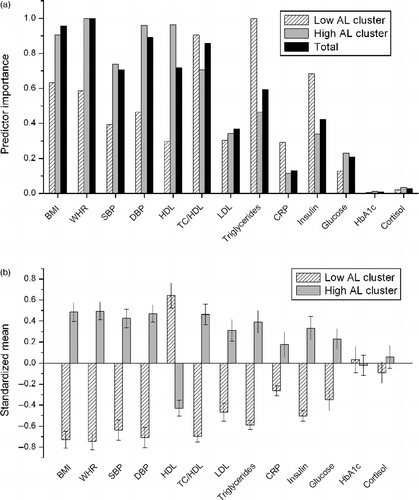Figures & data
Table I. Demographic factors for patients with stress-related exhaustion and controls.
Table II. Quartile distributions of all biomarkers and AL scores in patients with stress-related exhaustion and controls.
Table III. Results from the MANOVA performed to test differences between patients with stress-related exhaustion and controls for each of the 13 biomarkers.
Table IV. Separate analyses for men and women showing the results from the MANOVA performed to test differences between patients with stress-related exhaustion and controls for each of the 13 biomarkers.
Figure 1. Two clusters were identified by multivariate analysis, including all 13 AL markers and 87 patients with stress-related exhaustion and 83 controls. (a) Relative importance of each AL biomarker for the two clusters and for the total model. (b) Characteristics of the two clusters illustrated by cluster mean values of standardized AL biomarker data; each biomarker has mean 0 and SD 1. Low AL (Cluster 1), n = 68 participants (29 patients; 39 controls); High AL (Cluster 2), n = 102 participants (58 patients; 44 controls). Note, total n = 170 participants as there was a missing Biomarker value for 10 of the original 180 participants. AL markers: BMI, body mass index; WHR, waist–hip ratio; SBP, systolic blood pressure; DBP, diastolic blood pressure; HDL, serum high-density lipoprotein; TC, serum total cholesterol; LDL, serum low-density lipoprotein; triglycerides, serum concentration; CRP, serum C-reactive protein; insulin, serum concentration; glucose, plasma concentration; HbA1c, blood glycated haemoglobin; cortisol, mean morning salivary concentration.

